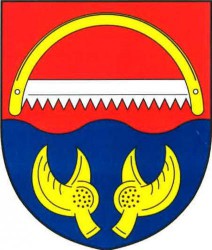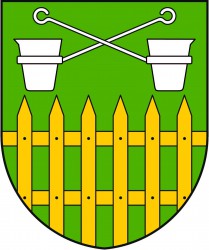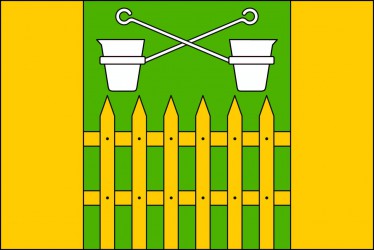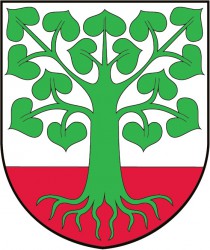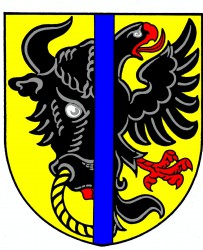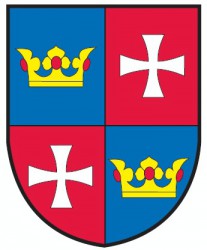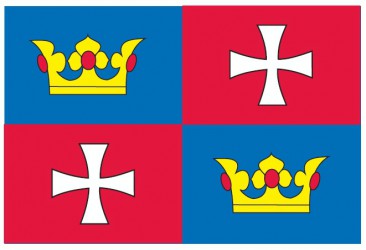Municipal heraldry designs
If you want to make a quality design of a town coat of arms, it is necessary to know and respect the expert heraldic and vexillological conventions for creating and describing a symbol, such as a coat of arm, a heraldic achievement (heraldry), a flag, or a banner (vexillology). The appearance of municipal coats of arms and their individual symbols is based on the town’s history and local traditions. In the process of creating a design of your symbol, there is obviously space for your ideas and comments, and of course, findings about your town’s history.
With your help, our heraldic office will create a professional graphic design of a coat of arms or a town flag. In addition, we will oversee the entire procedure of obtaining the symbols until the moment you’ll get the approval from the hands of the President of the Chamber of Deputies - a certificate of authority to use your new symbols.
The importance of coats of arms created for villages, towns and townships
A flag and a coat of arms - the symbols that according to the law every village, town and township in the Czech Republic can use. However, there are a number of towns that do not have their own symbols. Every municipal flag and coat of arms raises not only the prestige and authority of the local government during important visits from the Czech Republic or abroad, but also the self-esteem of the population. Through these symbols, you will communicate with both the citizens and the public (tourists, new residents). To have your own flag and coat of arms means to materialize your identity. You can also use an unofficial, but very representative, banner (standard) of the mayoral office, handstamp with the coat of arms, communal colors, etc.
How are flags and coats of arms made?
The designing of a flag and a coat of arms is preceded by extensive historical and archival research. The aim is to find out what was typical or even completely unique about the settlement in the past. We look for something that characterizes the place and distinguishes it from any other. It is very important if there is a historical seal (sigillographic material), anything that is drawn or written on it can be used for the creation of the new symbol. This may be a deed of possession (whether the town was the property of the nobility or the Church), or the consecration of the local church or chapel to a particular saint (so-called patrocinium). The name of the town can also play an important role, the name can be rendered on a coat of arms using a certain charge (for example a hawk [in Czech jestřáb] in case of the town Jestřebí). The symbol can also mirror the local geographical curiosities or historic landmarks using the heraldic symbolism. Besides having the expert knowledge and years of experience, it is essential to have the ability to think as both a graphic designer and heraldic expert. Only then, truly valuable designs can be created - designs that will stand the test of time. The flags and the coats of arms may be designed in the present, but their purpose is to endure the centuries and become truly historic symbols.
How to design a flag and a coat of arms correctly and without errors?
Sometimes, we encounter ideas that one can put almost anything in a coat of arms, or that you can put in objects in their actual real-life appearance, or even photographs. However, in a proper heraldic symbol, everything must be substituted and symbolized. For over eight hundred years, heraldry has been expressed precisely and clearly through heraldic ordinaries (we can say geometric), heraldic charges (generally applicable, and able to specifically described and rendered) and heraldic tinctures − in Czech environment, two metals (gold and silver) and four colors (red, blue, green, and black). Only in exceptional cases, we may use the so-called natural color, for example for the trunk and the tree-top of a linden or a larch, for wooden handles of instruments, or for various animals.
Approval of the heraldic design
Heraldic design must be discussed in the Subcommittee for Heraldry and Vexilology, who will then recommend the design for approval by the President of the Chamber of Deputies. He then issues a decision about granting a coat of arms and a flag. From that moment on, a village, a town, or a township has the authority to use their own symbols and call them a coat of arms and a flag. The symbols are also legally protected, for example, the town coat of arms may not be used by anyone without the town’s approval.
Examples of municipal heraldry created in our company’s office
- The design of the coat of arms and the flag for Klokočov
- The coat of arms and the flag for Rudolec
- The design of the coat of arms and the flag for Třebnouševes
About heraldry and vexillology
Heraldry is an auxiliary science of history that deals with the summary of rules and conventions by which a coat of arms is created, described (expertly blazoned and historized), designated and drawn. The name is derived from the Latin word "heraldus", i.e. herald - an expert on the study and proper use of coats of arms (heraldic achievements), including studies of pedigree (genealogy), ceremony (etiquette) and diplomacy. Heralds created the so-called blazon, i.e. the description of an achievement with special heraldic terminology. Vexillology is a younger auxiliary science of history that deals with history, symbolism and use of flags and banners, including the conventions of their creation, design, accurate description and creation. The name comes from the Latin word "vexillum", the diminutive form of "velum" (sail), describing a cloth of a special purpose fixed to crossbar attached to a flagpole (that is, a flag, or more precisely the banner of the Roman legions). According to the basic rules of heraldry, every coat of arms must bear metals (gold and silver, in practice displayed as yellow and white) and colors (red, blue, green, black), and in exceptional cases also brown for trunks of trees, or the fur of some animals, etc. At the same time, strict rules about alternate contrast display of metal and color apply (i.e. metal charges in color fields of the shield, and vice versa). Heraldic figures are divided into so-called ordinaries, i.e. geometrical (variations of the field) and charges, such as animals, instruments and other objects, however, these are always rendered and stylized two-dimensionally. A coat of arms is always blazoned from the shield bearer’s perspective (his right arm), never from the observer’s perspective, you could say it is described (seemingly) backwards. Drawings of a coat of arms may differ over time depending on an author - it is not a logo or a trademark. However, from the moment the President of the Chamber of Deputies signs the decree about the symbol, a binding definition of the coat of arms is created and it must always be exactly and consistently followed (with all mentioned tinctures and charges in a composition of a coat of arms, flag or banner). Blazon is a heraldic term for an exact and expert description of a coat of arms, with which every experienced heraldist can draw the symbol without ever seeing the original artwork. A (municipal) flag (hoisted on a flagpole), or a banner (firmly attached to a flagpole) consists of a so-called field with an usual aspect ratio 2:3 (vexillologically speaking), following the same ratio of the national flag of the Czech Republic. The flag’s appearance is usually based on an existing coat of arms. Unlike in heraldry, where blazoned gold and silver (heraldic metal) is depicted as yellow and white, flag’s colors are always described as yellow or white, since the flag’s fabrics are manufactured in these colors. Act No 128/2000 Coll., on Municipalities (the Municipal Order) allow not only the use of existing historical heraldic coats of arms and flags, but also granting of such new symbols to a municipality who does not have any, and even allows a so-called revocation of municipal symbols, i.e. official change of an existing coat of arms or flag/banner (a historical one or one granted after 1990) by issuing a new decree by the President of the Chamber of Deputies, according to the law on municipalities and the rules of procedure of the Chamber of Deputies.

